 A catalogue of illusions
A catalogue of illusions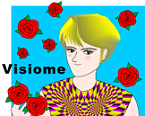
 A catalogue of illusions
A catalogue of illusions
Access since September 22, 2004
Renewal April 2008
| < Geometrical illusion (illusion of shape) > | ||
|
Müller-Lyer illusion |
The two horizontal bars are the same in length but the lower one appears
to be much longer than the upper one. Click this image, and a high-resolution bitmap of the Müller-Lyer
illusion will be available. Click this image, and a high-resolution bitmap of the Müller-Lyer
illusion will be available. |
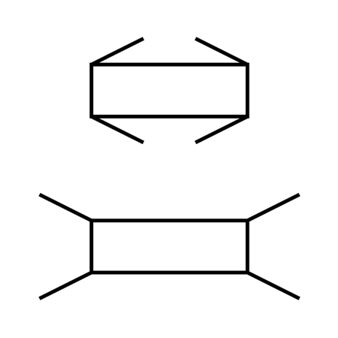 |
Waite-Massaro illusion | Two rectangles are the same shape and the same size, but the upper one appears to be shorter and thicker than the lower one. Waite, H. and Massaro, D. W. (1970). Test of Gregory's constancy scaling explanation of the Müller-Lyer illusion. Nature, 227, 733-734. 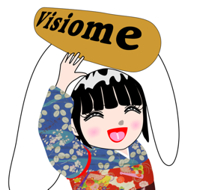 |
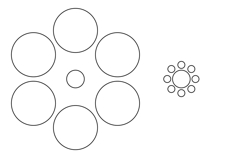 |
Ebbinghaus illusion (Titchener illusion) (Ebbinghaus illusion of size) (Ebbinghaus size illusion) (Ebbinghaus areal illusion) |
A circle is surrounded by larger circles appears to be smaller than the
circle of the same size that is surrounded by smaller circles. updated October 17, 2012 updated October 17, 2012 |
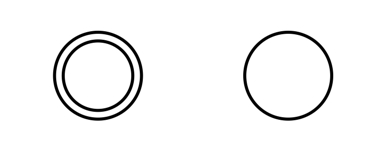 |
Delboeuf illusion, underestimation of the outer circle | A circle appears to be smaller than it is when a slightly smaller circle
is drawn in it. |
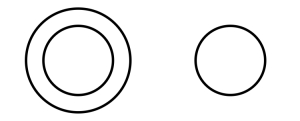 |
Delboeuf illusion, overestimation of the inner circle | A circle appears to be larger than it is when it is surrounded by a slightly
larger circle. |
 |
Delboeuf illusion, underestimation of the inner circle | A circle appears to be smaller than it is when it is surrounded by a much
larger circle. |
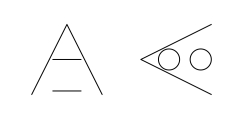 |
Ponzo illusion |
The object nearer to the apex appears to be larger than the other of the
same size. |
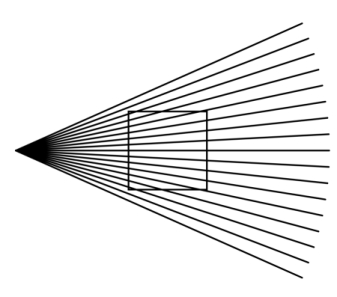 |
Ehrenstein illusion (Ehrenstein 1925) |
The square appears to be distorted in which the right side appears to be tapered. |
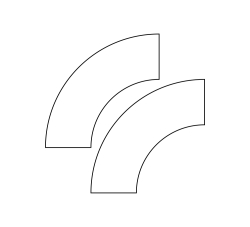 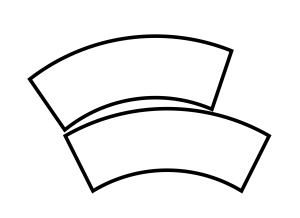 |
Jastrow illusion | The two curved figures are of the same size but the inner one appears to
be larger than the outer one. Actually, this illusion was first presented by Müller-Lyer (1889), not by Jastow (1891). (the upper image) (the upper image) |
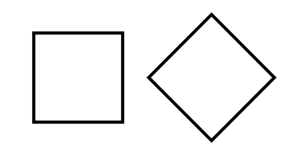 |
"Square-diamond illusion" | If a square is rotated through 45 degress, it appears to be larger than
the normal display. Schumann, F (1900), "Beiträge zur Analyse der Gesichtswahrnehmungen." Zeitschrift für Psychologie und Physiologie der Sinnesorgane 23: 1–32; 24: 1-33. (... Erste Abhandlung. Einige Beobachtungen über die Zusammenfassung von Gesichtseindrücken zu Einheiten. 23: 1–32) |
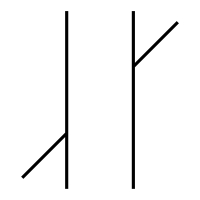 |
Poggendorff illusion | The right oblique line segment appears to be upper than the extension of
the left one, though they are just aligned. |
| The horizontal lines appear to tilt to the right and the left alternately.
This illusion is characterized by acute-angle expansion. Basic image  Image with five induced lines  |
||
 |
Hering illusion | The parallel line appear to curve outward.  |
| The gray line is horizontal but appears to tilt counterclockwise in the
upper image. In the lower image, the horizontal gray lines appear to tilt
clockwise, counterclockwise, clockwise, counterclockwise from the top to
the bottom, respectively. When the line is black, the illusions is called
the Münsterberg illusion. Basic image  Image with four induced lines  |
||
 |
checkered illusion | The black line is horizontal but appears to tilt down to the right. Basic image  Enhanced version  Enhanced version, two dimensional (dice type) 
|
 |
Illusion of shifted gradations | The gray line is horizontal but appears to tilt down to the left. |
 |
Illusion of striped cords | The black-and-white line is horizontal but appears to tilt down to the
left. |
| The limited case of the Café Wall illusion | Please read this paper: Kitaoka, A., Pinna, B., and Brelstaff, G. (2004). Contrast polarities determine the direction of Cafe Wall tilts. Perception, 33, 11-20. |
|
 cf. Cafe Wall illusion shown below (  ) ) |
Reverse Café Wall illusion | The black-and-white line is horizontal but appears to tilt clockwise. |
 |
Illusion of Y-junctions | In this image, the middle horizontal edge appears to tilt counterclockwise
(Kitaoka, Pinna and Brelstaff, 2001, 2004). |
 |
Illusion of fringed edges | In this image, the middle horizontal edge appears to tilt counterclockwise
(Kitaoka, Pinna and Brelstaff, 2001, 2004). |
 |
Illusion of shifted edges | In this image, the whole row appears to tilt counterclockwise though shifted
rectangles are horizontally aligned (Kitaoka, Pinna and Brelstaff, 2001,
2004). |
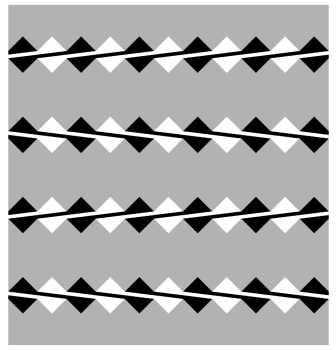 |
Fraser illusion | When slightly tilted line segments are aligned horizontally like the figure,
the whole array appears to tilt toward the tilt of the line elements. This
is a reversal of the Zöllner illusion or acute-angle contraction. |
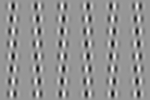 |
Popple illusion | The phase-shift illusion. When Gabor patches are aligned vertically and the phase of carriers is adequately shifted, the row of the envelope windows appear to tilt toward the shift. |
 |
Oppel-Kundt illusion | The physical center is the second one from the right, which appears to
shift rightward. |
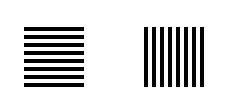 |
Helmholtz square | The vertical side of a square appears to be longer than the horizontal
side when the square is filled with a horizontal grating, and vice versa. |
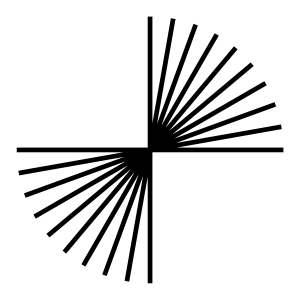 |
Helmholtz's angle expansion | The vertical appears to tilt counterclockwise while the horizntal appears to tilt clockwise. |
 |
Fick illusion | The vertical line and the horizontal line are the same in length but the
former appears to be longer that the latter. |
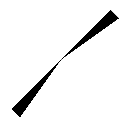 |
Bourdon illusion | The upper side of the left-lower triangle is actually aligned with the upper side of the right-upper triangle, the former appears to tilt counterclockwise while the latter clockwise. |
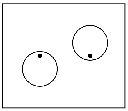 |
Giovanelli illusion | Each dot surrounded by a larger circle appears to shift in position away from the center of the circle. |
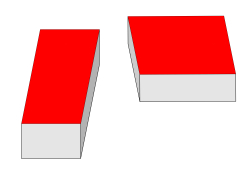 |
Shepard illusion (table-top illusion) |
The left parallelogram appears to be slimmer than the right one, though
they are identical in shape and size. Shepard, R. N. (1990) Mind sights: original visual illusions, ambiguities, and other anomalies, with a commentary on the play of mind in perception and art. New York: Freeman. His original was first reported in 1981: Shepard, R. N. (1981) Psychophysical complementarity. in Kubovy, M. and Pomeranz, J. (Eds.), Perceptual Organization, Hillsdale, NJ: Lawrence Erlbaum Associates, pp. 279-341. (see p.298) Actually, this phenomenon was first demonstrated by Tatsro MAKINO in 1975 before R.N. Shepard. <March 26, 2012> Makino, T. (1975). Comparison process as a factor of size-distance relationship. Psychologia, 18, 104-109.  |
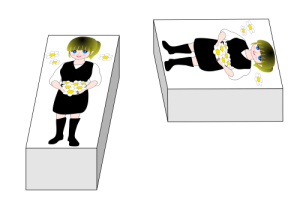 |
Assimilation or capture to the Shepard illusion | An image drawn in the parallelogram of the Shepard illusion appears to
be distorted, captured by the Shepard illusion. |
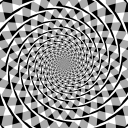 |
Fraser's spiral illusion | Concentric circles appear to be spirals. Adobe Illustrator file (version 8)  |
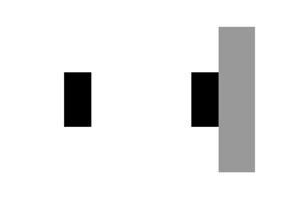 |
amodal expansion | The two black rectangles are of the same size but the right one appears
to be elongated horizontally. Kanizsa G, Luccio R, 1978 “Espansione di superficie da completamento amodale'', reports from the Institute of Psychology, University of Trieste, Trieste, Italy. Vezzani, S. (1999) Shrinkage and expansion by amodal completion: a critical review. Perception, 28, 935-947. |
< Illusion of brightness or lightness) > |
||
 |
brightness contrast (lightness contrast) | A gray area surrounded by a darker background appears to be brighter (lighter)
than it is, while a gray area surrounded by a brighter (lighter) background
appears to be darker than it is. |
 |
brightness assimilation (lightness assimilation) | The gray background with black lines appears to be darker while the gray
background with white lines appears to be lighter. |
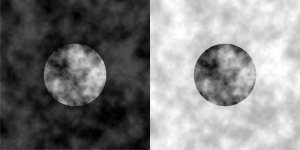 |
Anderson's lightness illusion (Anderson and Winawer, 2005) |
The inset surrounded by the darker background appears to be lighter than the same pattern surrounded by the brighter background. The continuity of texture is critical in this illusion. |
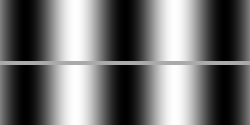 |
grating induction (McCourt, 1982) |
The physically homogeneous gray occluder shows an apparent brightness grating
that is counterphase with the luminance grating. When the occluder is of
the lowest or highest luminance of the grating, visual phantoms are observed. |
 |
White's effect (White, 1979) |
A gray grating placed on the black phase appears to be lighter than as it
is while one placed on the white phase appears to be darker as it is. In
this image, the gray in the left half appears to be lighter than that in
the right half, though they are identical in lightness. White's effect
can be thought of as the achromatic Munker illusion. |
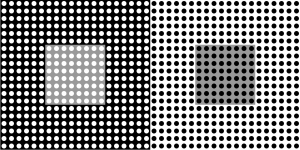 |
White's dotted lightness illusion (White, 1982) |
The gray square in the left half appears to be lighter than that in the right half, though they are the same in lightness. This illusion does not depend on T-junctions. |
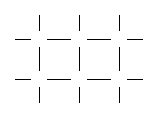 |
Ehrenstein's figure (Ehrenstein, 1941) |
The illusory circles appear to be brighter than the background though they are of the same luminance. |
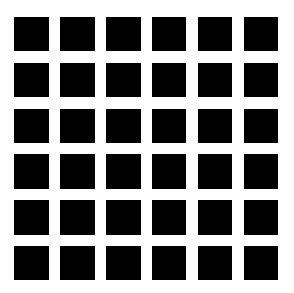 |
Hermann grid illusion (Hermann, 1870) |
There appear to be dark dots on the crosses of white streets. |
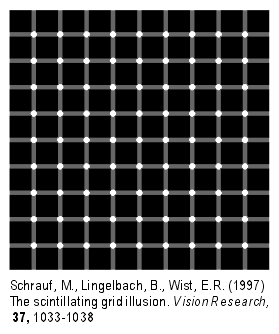 |
Scintillating grid illusion | Illusory black dots appear to scintillate in white circles. cf. Bergen's illusion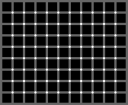 -> ->
|
|
|
Bergen illusion | Black flashes appear to scintillate in white crosses. |
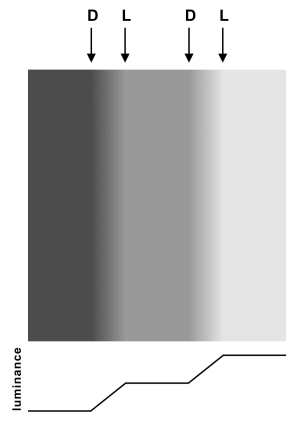 |
Mach band | Illusory dark (D) or light (L) lines are observed at the borders between
homogeneous luminance fields and luminance gradients. |
 |
Craik-O'Brien-Cornsweet effect | It appears as if there were dark, light, dark and light fields when seen
from the left to the right, they are actually of the same luminance. |
 |
Chevreul illusion | When a dark image and a light image are connected to each other, the border of the former appears to be darker while that of the latter appears to be lighter. This illusion is frequently called the "Mach band", which is wrong, however. |
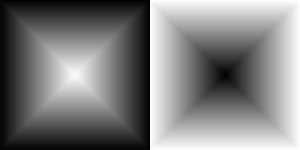 |
Vasarely illusion (Jameson and Hurvich, 1975; Morgan, 1996; Ninio, 2001; Martinez-Conde and Macknik, 2001) |
The diagonals appear to be light in the right image while they appear to
be dark in the right image, though there are no luminance changes in diagonals.
Jameson and Hurvich (1975, Leonardo, 8, 125-131, p.129) pointed out this
effect in works of Victor Vasarely, the most famous op artist.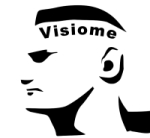 |
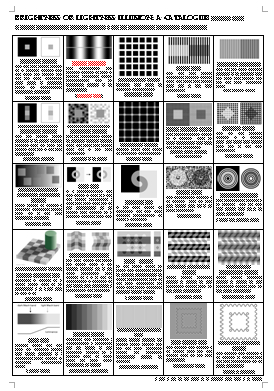 |
Catalogue of brightness or lightness illusions "Professor Mark McCour's talk in Ritsumeikan 2008" version |
 |
< Illusion of color > |
||
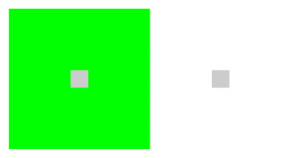 |
Color contrast (Chromatic contrast) |
When a small patch is surrounded by a color field, the patch appears to
be tinted in the opponent color of the surrounding field. In this image,
a gray patch appears to be tinted reddish when surrounded by a green field. |
 |
Color assimilation (Chromatic assimilation) |
The gray background with blue lines appears to be bluish while the gray
background with yellow lines appears to be yellowish. |
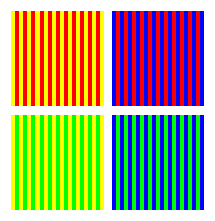 |
Color assimilation | The orange and purple-red shown in the upper row are the same red, and the yellowish-green and bluish green displayed in the lower row are the same green. |
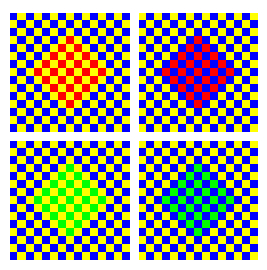 |
De Valois, and De Valois's (1988) color assimilation | The orange and purple-red shown in the upper row are the same red, and the yellowish-green and bluish green displayed in the lower row are the same green. |
 |
Saturation contrast | When a small patch is surrounded by a field that is of the same color but
of stronger saturation, the patch appears to be tinted less vivid (less
saturated). On the other hand, when a small patch is surrounded by a field
that is of the same color but of weaker saturation, the patch appears to
be tinted more vivid (more saturated). In this image, the right small patch
appears to be more vivid than the left one, though they are the same in
color and saturation. |
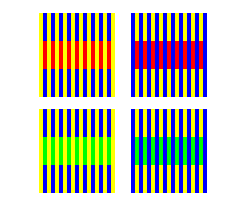 |
Munker illusion (Munker, 1970) |
The orange and purple-red shown in the upper row are the same red, and
the yellowish-green and bluish green displayed in the lower row are the
same green. The Munker illusion is the chromatic White effect. |
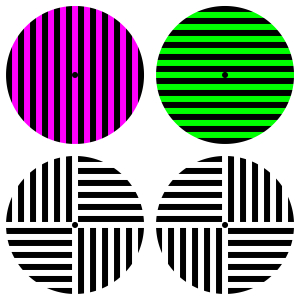 |
McCollough effect (McCollough, 1965) |
After alternately viewing a vertical stripe of black and magenta and a
horizontal one of black and green, observers see illusory green in a vertical
stripe of black and white and illusory magenta in a horizontal one of black
and white. |
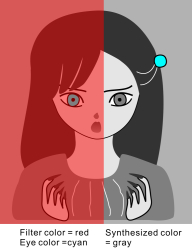 |
Color constancy new! |
The right eye appears to be bluish while the left eye appears to be gray,
though both are physically gray. |
< Visual completion > |
||
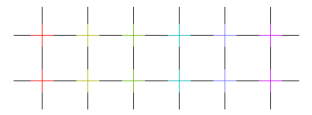 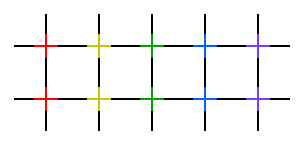 |
Neon color spreading (Varin, 1971; Van Tuijl, 1975) |
When crossing points of a black grating in front of a white background
are replaced with color crosses, the color appears to go out into the background. <references>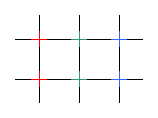  |
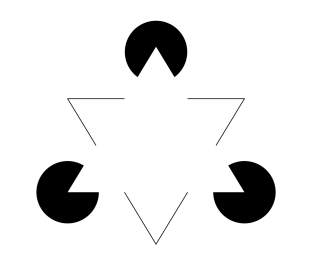 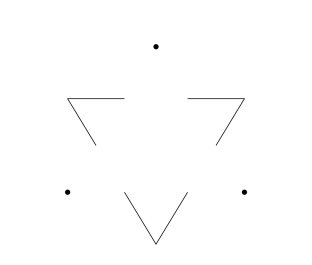 |
Kanizsa triangle Kanizsa (1955, 1976, 1979) |
An illusory triangle appears to be in front of three black circles and
a line-drawing triangle, though there are not complete circles or a complete
line-drawing triangle. Dots also work instead of pacmen. Kanizsa, G. (1955) Margini quasi-percettivi in campi con stimolazione omogenea. Rivista di Psicologia, 49, (I), 7-30. (Figures 11 and 13) for PDF  |
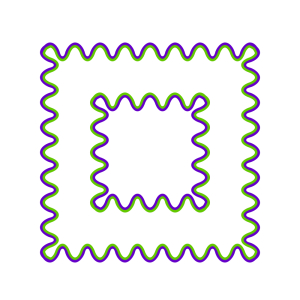 |
Watercolor illusion | In this image, the corridor part of the square appears to be tinted green
though it is white (Pinna, Brelstaff and Spillmann, 2001; Pinna, Werner
and Spillmann, 2003). Samples of watercolor illusion  |
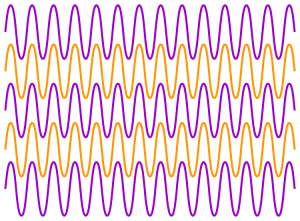 |
Wave-line color illusion | The white background appears to be tinted orange behind orange waves. Sohmiya, S. (2007) A wave-line colour illusion. Perception, 36, 1396-1398. |
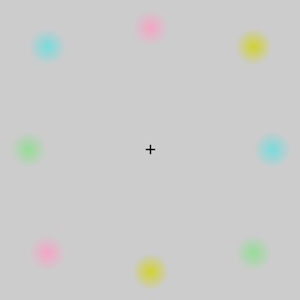 |
Troxler effect (peripheral fading) |
Colored circles appear to extinguish when observers fix their eyes on the
central cross. |
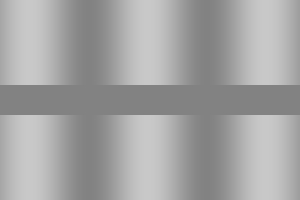 |
Visual phantoms (stationary phantoms) |
When a dark-to-light luminance grating is occluded by a dark occluder,
the dark regions of the grating appear to cross in front of the occluder. Gyoba, J. (1983) Stationary phantoms: A completion effect without motion and flicker. Vision Research, 23, 205-211. Kitaoka, A., Gyoba, J., and Sakurai, K. (2006) Chapter 13 The visual phantom illusion: a perceptual product of surface completion depending on brightness and contrast. Progress in Brain Research, 154 (Visual Perception Part 1), 247-262. PubMedPBR PDF Reprint request to me  |
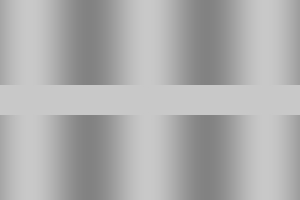 |
Visual phantoms ('light' stationary phantoms) |
When a dark-to-light luminance grating is occluded by a bright (light)
occluder, the bright (light) regions of the grating appear to cross in
front of the occluder. Sakurai, K. and Gyoba, J. (1985) Optimal occluder luminance for seeing stationary visual phantoms. Vision Research, 25, 1735-1740.  |
< Illusion of visual motion > |
||
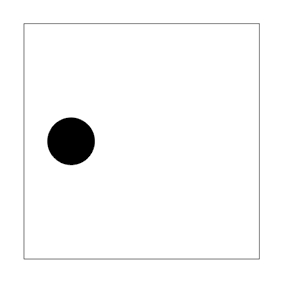 |
Apparent movement | Objects appear to shift between two stationary images when presented successively. |
| Motion aftereffect | After watching a moving pattern for a while (adaptation) and switching
the gaze to a stationary image, the observer sees the visual field where
he/she kept watching the motion move in the opposite direction. References An adaptation stimulus to visual motion is available in Visiome.  |
|
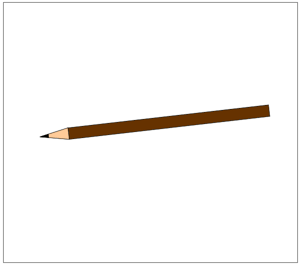 |
Rubber pencil illusion | A pencil appears to bend when wiggled. Pomerantz, J. R. (1983) The rubber pencil illusion. Perception & Psychophysics, 33, 365-368.  |
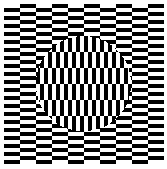 |
Ouchi illusion (Ouchi, 1977; Spillmann et al 1986) |
The inset appears to move. |
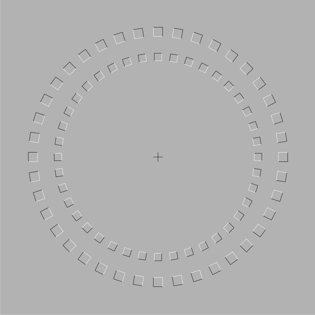 |
Pinna illusion (Pinna and Brelstaff, 2000) |
Rings appear to rotate when observers approach or leave the image fixing their eyes on the center. This way of demonstration, the looming method, is also Pinna's invention. See: http://www.scholarpedia.org/article/Pinna_illusion Pinna, B. and Brelstaff, G. J. (2000) A new visual illusion of relative motion. Vision Research, 40, 2091-2096. Parallel motion versions were first published in Pinna's book written in Italian. Pinna B, 1990 Il Dubbio sull'Apparire (Padua: Upsel Editore) Parallel motion versions were shown in the English paper shown below, too. Pinna, B. and Spillmann, L. (2005) New illusions of sliding motion in depth. Perception, 34, 1441-1458. |
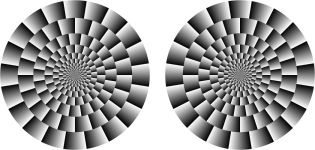 |
Fraser-Wilcox illusion (Fraser and Wilcox, 1979) |
Disks appear to rotate spontaneously. Many people see counterclockwise rotation in the left disk and clockwise rotation in the right disk; some people see the reversal. This individual difference is hereditary. |
| Optimized Fraser-Wilcox illusion (Kitaoka and Ashida, 2003) (This illusion might possibly be different from the blink-dependent illusion in Faubert and Herbert's peripheral drift illusion) |
Stationary objects appear to move "spontaneously". The direction of motion is black » dark-gray » white » light-gray » black. | |
 |
Optimized Fraser-Wilcox illusion, Type I (Ashida and Kitaoka, 2003; Backus and Oruç, 2005; Kitaoka, 2006) |
Stationary objects appear to move "spontaneously". The direction of motion is black » dark-gray, and white » light-gray. |
 |
Optimized Fraser-Wilcox illusion, Type IIa (Kitaoka, 2006) |
Stationary objects appear to move "spontaneously". The direction
of motion is black » dark-gray » white » light-gray »
black. I think that "Rotating snakes" depends on this illusion. |
 and central drift illusionss.jpg) |
Comparison between the peripheral drift illusions (optimized Fraser-Wilcox illusion, Type I) and the central drift illusions | a normal-size image a larger image a still larger image Copyright Akiyoshi Kitaoka 2010 (December 11) |
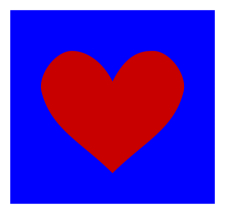 |
The fluttering heart | A red heart on the blue background appears to move in visual periphery in mesopic vision. |
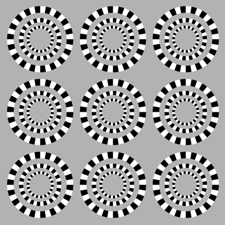 |
Refreshment-dependent rotation illusion | Blink, saccade (eye movement) or flicker gives illusory rotation of rings. References Kitaoka, A., Murakami, I. and Ashida, H. (2006) Effects of flicker and blink on anomalous motion illusion. Talk in the 2006 Winter Meeting of Vision Society of Japan, Kogakuin University, Shinjuku, Tokyo, Japan, on January 28, 2006. Talk  |
< Others > |
||
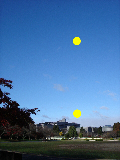 |
Moon illusion | The horizon moon appears to be larger than the elevated moon. References |
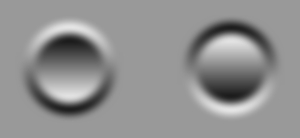 |
Crater illusion | The left image appears to be a concave surrounded by a convex, while the right
one appears to be a concave surrounded by a concave. Actually, the latter is
excatly the inverted image of the former. |
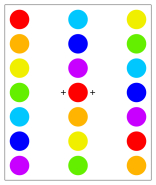 |
Chromatic negative afterimage | Fix your eyes on either of the fixation points (crosses) for several seconds. Then, move your eyes to the other fixation point, and chromatic negative afterimages appear. |
 |
A schematic explanation of depth-reversal silhouette figures, including the silhouette illusion (Kayahara, 2003) |  |
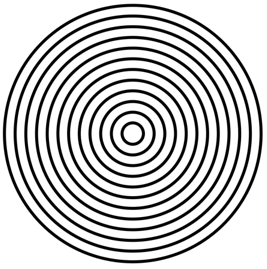 |
One variation of "op effect" | Something "noisy" that is perpendicular to a grating of high
spatial frequency appears to scintillate. |
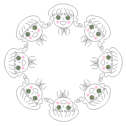 |
Reversible figure of apparent movement | The ring appears to rotate clockwise or counterclockwise. The direction is changeable. |
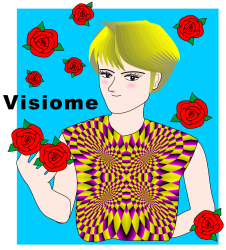 |
An illusion design to advertise Visiome (This is not the formal design of Visiome) <April 27, 2008> |
Visiome Platform is a digital research resource archive for vision science. The available resources include mathematical models, experimental stimuli, experimental data, and analytical tools. Visiome |
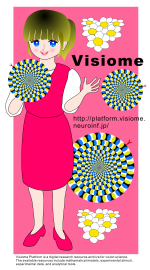 Copyright Akiyoshi Kitaoka 2008 (April 26; July 31) |
An illusion design to advertise Visiome (This is not the formal design of Visiome) <April 26, 2008> |
Visiome Platform is a digital research resource archive for vision science. The available resources include mathematical models, experimental stimuli, experimental data, and analytical tools. Visiome Click this image, and a high-resolution bitmap (4800 x 8653 pixel) of this
advertising image will be available. Click this image, and a high-resolution bitmap (4800 x 8653 pixel) of this
advertising image will be available. |
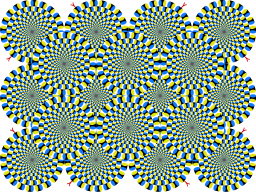 |
"Rotating snakes" (illusion work) |
Each disk appears to rotate spontaneously. (JPEG file, 9900 x 7425, 33MB)  (SVG file, 5MB) <April 29, 2012> |
Classification of anomalous motion illusions
(August 30, 2004)
Comprehensive classification of illusions
(February 15, 2005)
A catalogue of visual illusion, MS-Word version
(February 20, 2005)
Classification of color illusion
(May 30, 2005)
Thanks to Walter